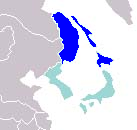Ezo

| |

| |
| Official Languages | Japanese, Corean, Ainu |
| Other Languages | Russian |
| Major Religions | Xintò (Shinto), Buddhism, Christianity (particularly Russian Orthodox) |
| Capital | 札幌 Sapporo |
| Government Type | Monarchy/Republic |
| First Citizen | Regent Maco, Princess Masaxi |
| Prime Minister | 泉安英 Izumi Yasuhide |
| Incorporation | Saisei 41, Gogaçu 8 June 12, 1992 |
| Currency | Lò = 16 Xu = 400 Fun |
| Supranational Organizations | Part of Japanese Empire |
| Major Subdivisions | 19 provinces; includes Condominium territory of Gaimanxù |
Ezo, at one time known as Hoccaidò, is the northernmost island in the Japanese archipelago. It was the last stronghold of the Ainu people after being expelled from Honxù. In the 18th century, the island was largely ignored by the Japanese and other peoples. Japanese fishermen and traders would visit the southern shore in the summer, but return to Honxù for the winter. By 1780, groups of Russian fur-trappers were visiting the island. The Japanese feared that the island would slip out of their control by default if they did not act promptly. And so, survey teams were sent to map out the northern sea and make maps of the islands. In addition, the xògun sent notice to the Russian government that Ezo belonged to them. As an additional precaution, in 1799, the Bacufu (xògun's government) took direct control of the island, which had previously been an administrative appendage to the Maçumae han. By the early 19th century, a treaty was drawn up with Russia granting them the northern shore and trading rights to the interior, while recognizing Japanese ownership of the rest of the island. In 1807, Japan laid claim to the island of Carafuto. In 1860, the Treaty of Ximoda was signed in which Japan ceded control of Carafuto (or Sakhalin as the Russians knew it), in return for Russia ceding all rights in Ezo and Txixima (the Kurile Islands).
Today, the island is the heart of the Republic of Ezo, a republic within the Japanese Empire. The Republic was initially created on Meidji 1, Jùitxigaçu 22 (December 25, 1868) by rebel Tocugawa loyalists. Their brief republic (the First Republic of Ezo) fell within a few months, and they fled across the Pacific to Oregon. The Republic was reborn (the Second Republic) in Xòwa 18 (1942) during the Japanese Civil War, when Ezo declared independence (see Republic of Ezo). The separatists enjoyed little support among the people, but Russia propped them up as a sattelite state, increasingly under the domination of SNOR. Between Xòwa 27 (1951) and Saisei 40 (1991), Ezo remained *there*'s version of Taiwan, disputed between Russia and the Japanese Empire. They overthrew the pro-SNORist Rational-Progressive Party in Saisei 40 (1991), and began the process of rebuilding and democratization, and reunification with Japan proper. On Saisei 41, Gogaçu 8 (June 12, 1992), a referendum held in Ezo approved reunification, and today Ezo is an integral part of the Empire of Japan, quickly growing and healing the wounds of almost half a century of SNORist dictatorship. Gogaçu 9 is now a national holiday, Reunification Day.
The Provinces of Ezo are (by geographical location, with capitals):
- Asian Mainland
- Gaimanxù (Condominium with Primorye of the Russian Federation)
- Carafuto
- Ezo Island
| |||
|---|---|---|---|
| States | |||
| Yamato | Corea | Lùquiù | Ezo | |||
| Protectorate | |||
| Nittatò | |||
| Condominium | |||
| Meidji-dò |